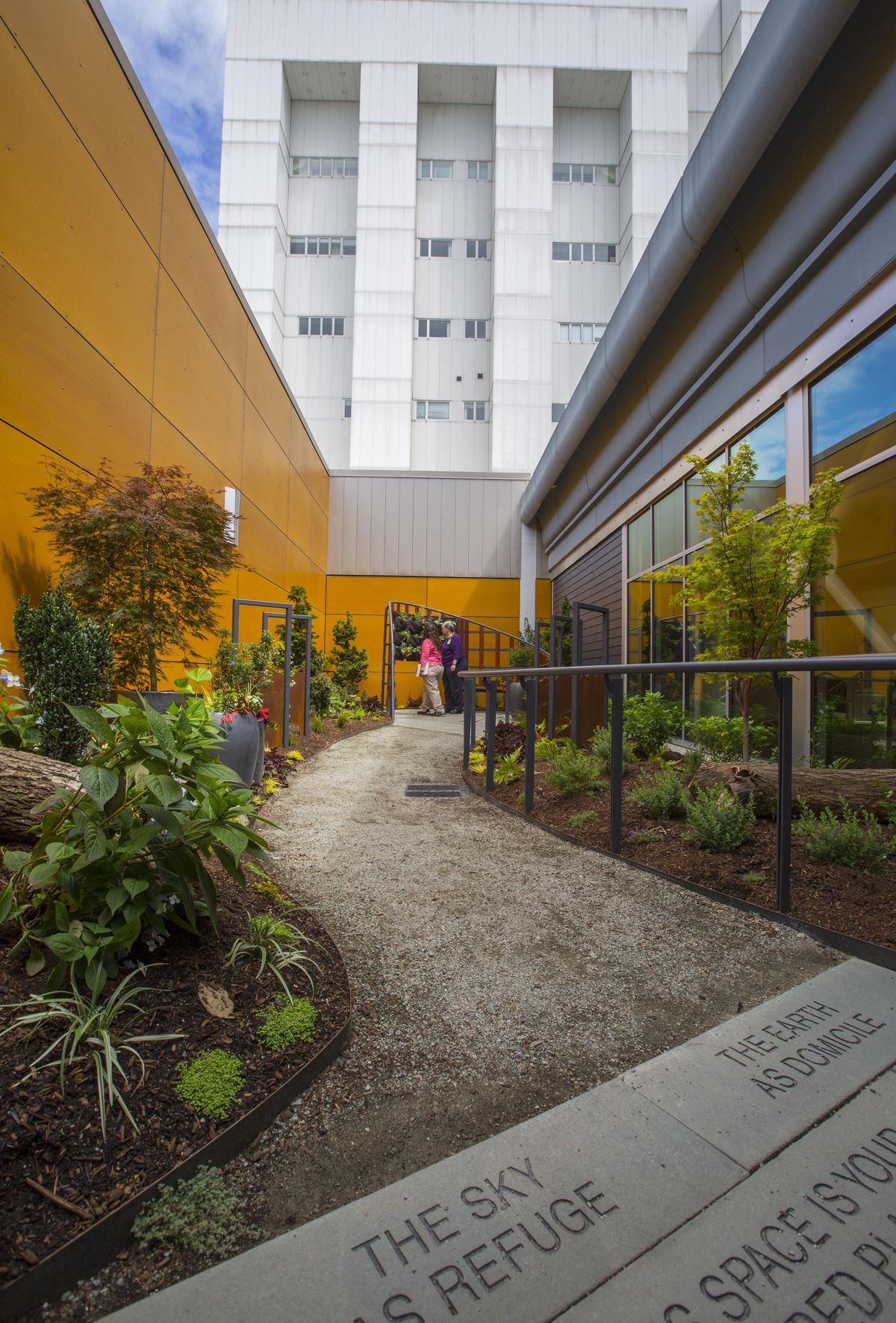Seattle VA hospital’s healing garden is a refuge from ravages of war, illness

SEATTLE – Long before he became a professor of landscape architecture and a designer of healing gardens around the world, Daniel Winterbottom had a seed planted in his very own heart.
It came from his mother, Miriam, who was diagnosed with ovarian cancer 30 years ago.
The hospital environment where she received treatment was “humiliating and degrading,” Winterbottom said recently. The only public meeting place was a room at the end of the hall. Sticky vinyl chairs. Fluorescent lighting.
So his mother found solace in the sight of a lone white pine tree that stood outside the window of her hospital room.
“One tree gave her a way to focus away from the chemo, the nausea,” Winterbottom said.
It was also, he would later learn, a “soft fascination” – an escape from the difficult thoughts around medical decisions, wills and all the worries that a prolonged hospital stay can ignite.
“You freak out, you panic,” said Winterbottom, who is 60. “The human capacity to deal with these issues is limited. And nature revitalizes you.”
With that – and his mother – in mind, Winterbottom and a group of his University of Washington students transformed a space of concrete and crushed rock at the Veterans Affairs hospital on Seattle’s Beacon Hill into a lush, light-filled sanctuary called a healing garden.
The design includes a lot of herbs, which not only have a scent, but are tactile, Winterbottom said. There are beds of native plants, a fountain with the soothing sound of water, and vines where birds can find refuge. And there are mahogany benches, where family members can sit out long medical appointments.
“It all makes you feel part of a system larger than yourself,” he said.
Doorways, paths and tables accommodate wheelchairs and gurneys. Chairs tilt back “so your mind can escape,” Winterbottom said.
“In a hospital, there is not a lot of beauty,” he said. “There’s anxiety and exhaustion. You don’t come here unless you need critical care.”
His firm, Winterbottom Designs, has installed healing gardens in New York City, Mexico, Guatemala, Bosnia-Herzegovina and Croatia.
And his book, “Therapeutic Gardens: Design for Healing Spaces,” includes chapters on gardens designed around movement, learning and sensory enhancement. There are gardens for the homeless, immigrants, obese children and those with cancer.
Healing gardens belong in places “where people are reaching their breaking point,” Winterbottom said.
Prisons. Psychiatric facilities. Juvenile-detention facilities. Refugee camps. And VA hospitals, where the echoes of war rattle louder and longer when there’s nothing to soften the sound.
“It really helps recovery, especially with combat veterans,” said Jeremy Watson, an affiliate assistant professor in Winterbottom’s department who helped with the design.
Watson’s contribution was critical, for he has seen things. He did two tours in Vietnam as a combat medic and receives treatment at the VA for PTSD.
“There’s no other respite from the sterility of the wards and the hospital itself,” Watson said, seated on one of the garden’s mahogany benches. “Until now, the closest green was at the Jefferson Golf Course next door. If you could make it that far.” (There is also a healing garden at the adjacent Fisher House, located on the VA campus.)
Many combat veterans relate to nature and animals better than other human beings, Winterbottom said.
He remembered neighbors in his native New Jersey who returned from the Vietnam War, then moved to faraway places like Idaho and Alaska.
“They wanted to be with nature and wildlife,” he said.
Meanwhile, the hospitals where veterans are treated are becoming increasingly dense and urbanized.
So there is more and more interest in healing gardens to settle veterans’ minds. And research proves gardens help reduce cortisol levels and aggressive behavior, and increase empathy and endorphins.
Ah, but this being a government facility, the VA project involved years of red tape and approvals before anything could be done. Then once construction started, patients, visitors and staff lined up along the windows to watch.
(The Veterans and Friends of Puget Sound helped raise $85,000 to build it.)
When the garden was officially opened last month, the crowd spilled down the halls. It was clear this would help people.
There were plenty of speeches and thanks. People waited patiently while the 27 UW students who put in 5,000 hours of construction received certificates and had their photo taken.
Then Winterbottom stood up and read a letter from an unnamed combat medic to his father, detailing the ravages of war. The professor choked back tears to read aloud the ending: “I love you, my father.”
“That was one of so many” veterans’ letters Winterbottom has seen, he said.
“For them, we hope the garden will provide a place of peace and restoration. That this will be a sanctuary in times of great stress, uncertainty and loss.”